The 5 Best Medical Alert Systems of 2025, Tested by Caregivers
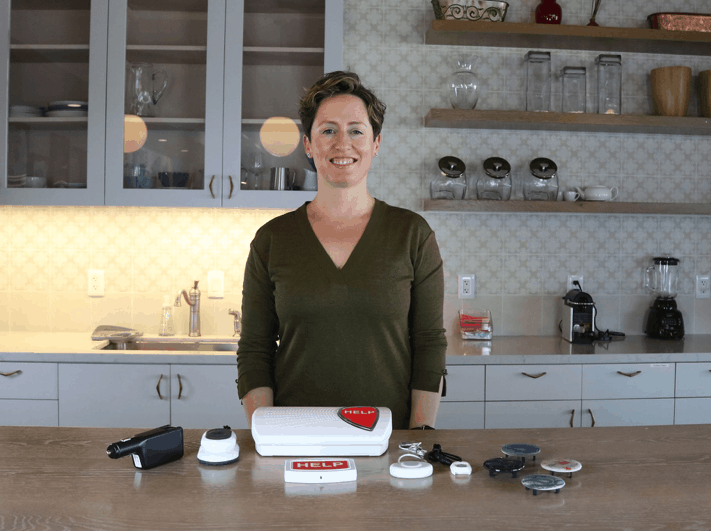
With quick response times, reliable equipment and affordable prices, Bay Alarm Medical is our top choice for medical alert systems. Medical Guardian had the fastest response times of any system, averaging eight seconds in our test calls, but the company’s prices are higher than average. With minimal fees and home systems starting at $24.95 per month, MobileHelp is our favorite budget option.
Why Trust Us
TheSeniorList team of caregivers, experts and health-care professionals conducted over 5,000 hours of research and testing to recommend the most reliable brands and devices. During the process, our team:
- Tested 50 medical alert devices from 15 brands
- Surveyed 1,250 seniors and caregivers in our medical alert system usage survey
- Consulted with nurses, EMTs and caregivers who are experts at caring for older adults
- Published dozens of videos that demonstrate our medical alert system testing1
- Evaluated verified customer reviews of medical alert companies from the Better Business Bureau

Our Top-Rated Medical Alert Systems
- Bay Alarm Medical : In-Home and Mobile Devices
- Medical Guardian : Fastest Response Times
- ADT : Best In-Home Systems
- MobileHelp : Best Budget Options
- Lively Mobile2 : Best Caregiver Features
Top Systems Compared
|
Bay Alarm Medical
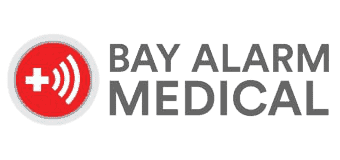 |
Medical Guardian
 |
ADT
 |
MobileHelp
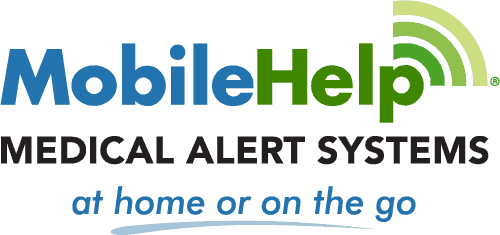 |
Lively Mobile2
 |
|
|---|---|---|---|---|---|
| Rating out of 5 | 4.8 | 4.7 | 4.6 | 4.5 | 4.1 |
| Average response time in seconds | 16 |
8 |
14 |
26 |
13 |
| Starting price per month | $24.95 |
$27.95 |
$26.99 |
$24.95 |
$24.99 |
| Cost of fall detection per month | $10 |
$10 |
$11 |
$5.50 |
$9.99 |
| Minimum contract | None |
None |
None |
None |
None |
| Read More | Bay Alarm Medical Review | Medical Guardian Review | ADT Review | MobileHelp Review | Lively Mobile2 Review |
Tip: According to recent census data, over 14 million seniors live alone.2 Having a reliable emergency response becomes crucial for maintaining independence.
Best Medical Alert Systems of 2025
Bay Alarm Medical - In-Home and Mobile Devices
What We Like Most:
- Systems starting at $24.95 per month
- 15-day risk-free trial
- Optional fall detection
- Location tracking on mobile units
Overview
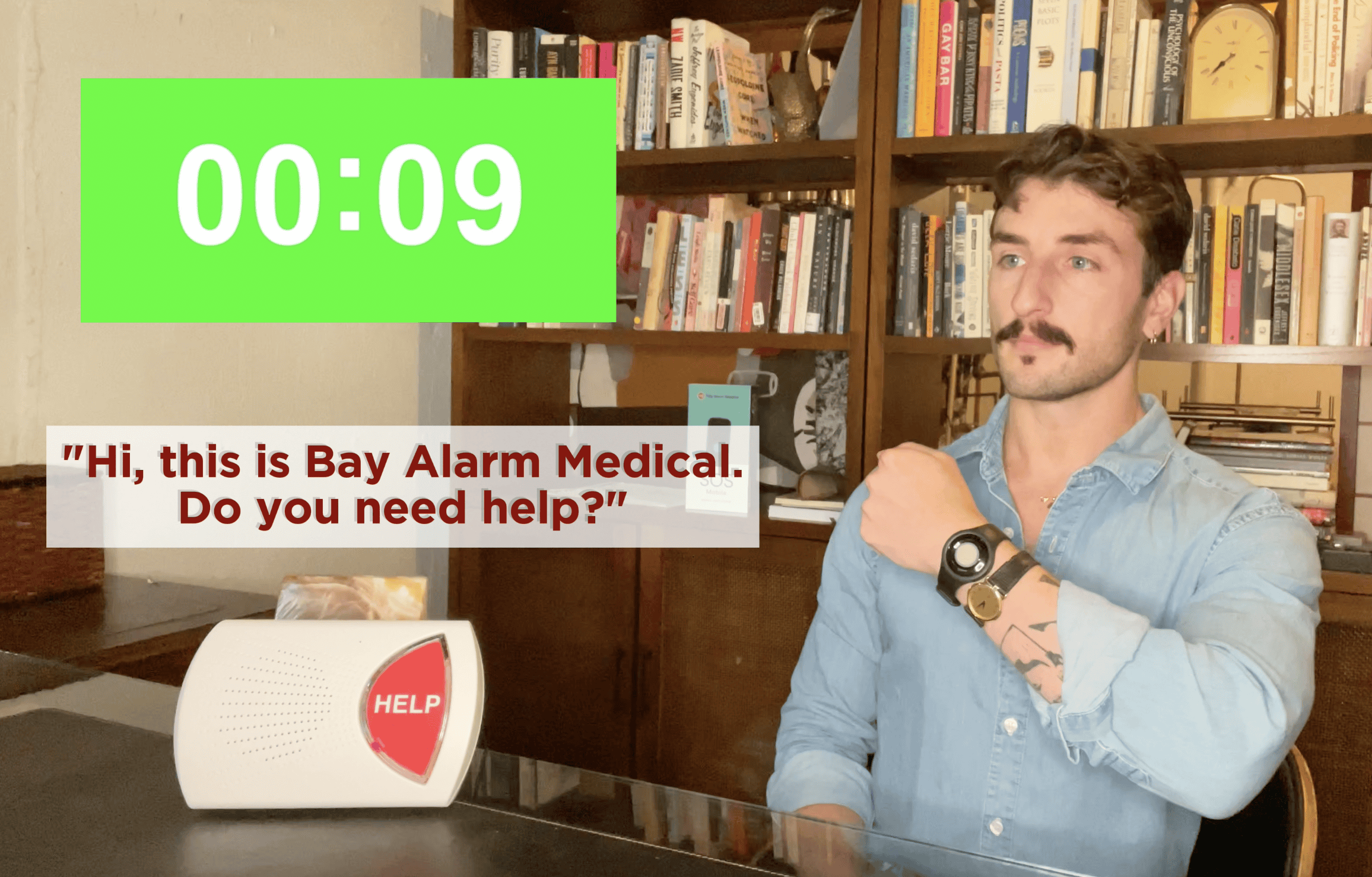
Bay Alarm Medical has long been the gold standard among medical alert systems, and its current lineup does not disappoint. Among the company’s home and mobile systems, we found fast response times, conscientious customer support and a plethora of extra features for caregivers.
Testing
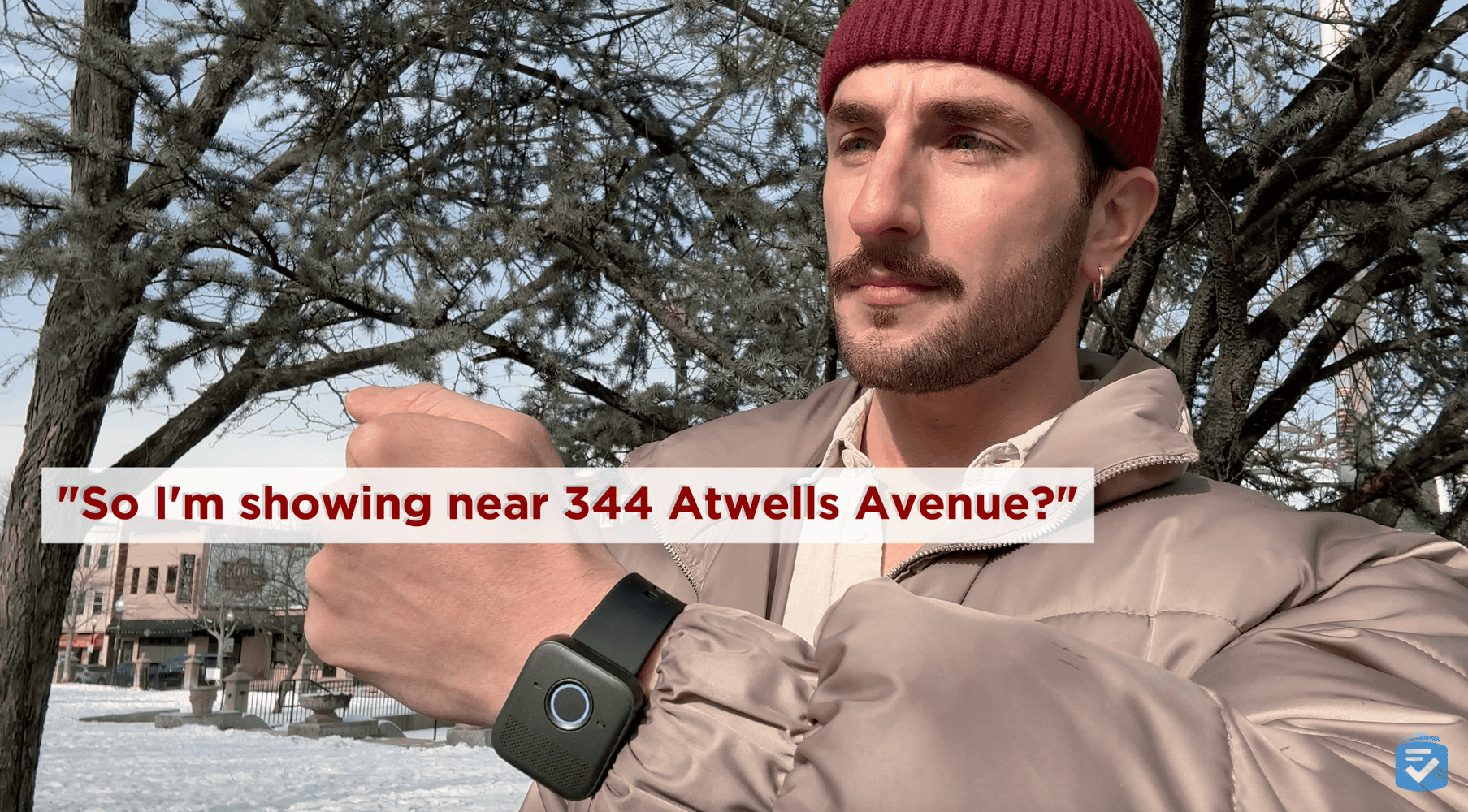
Across their various devices, we found that Bay Alarm Medical’s systems consistently gave us quick access to help. In our tests, the monitoring center answered our calls in an average of 16 seconds. Each distress call also alerted our designated caregivers through the Bay Alarm Medical app. The app also allowed us to track the location of our mobile systems when they were used outside the home.
We were pleased with the help buttons’ water resistance, which allowed us to take them into the shower without damaging them. Since the shower is a frequent site of falls, the feature would come in handy for many users. The automatic fall detection also worked well across Bay Alarm Medical’s systems. We were particularly impressed by the SOS Smartwatch’s fall detection, which detected 15 of 20 test falls.
Did You Know? Not every medical alert system includes fall detection. To make sure you get a system that can call for help without you pushing the button, check out our list of the best fall-detection devices.
Pricing
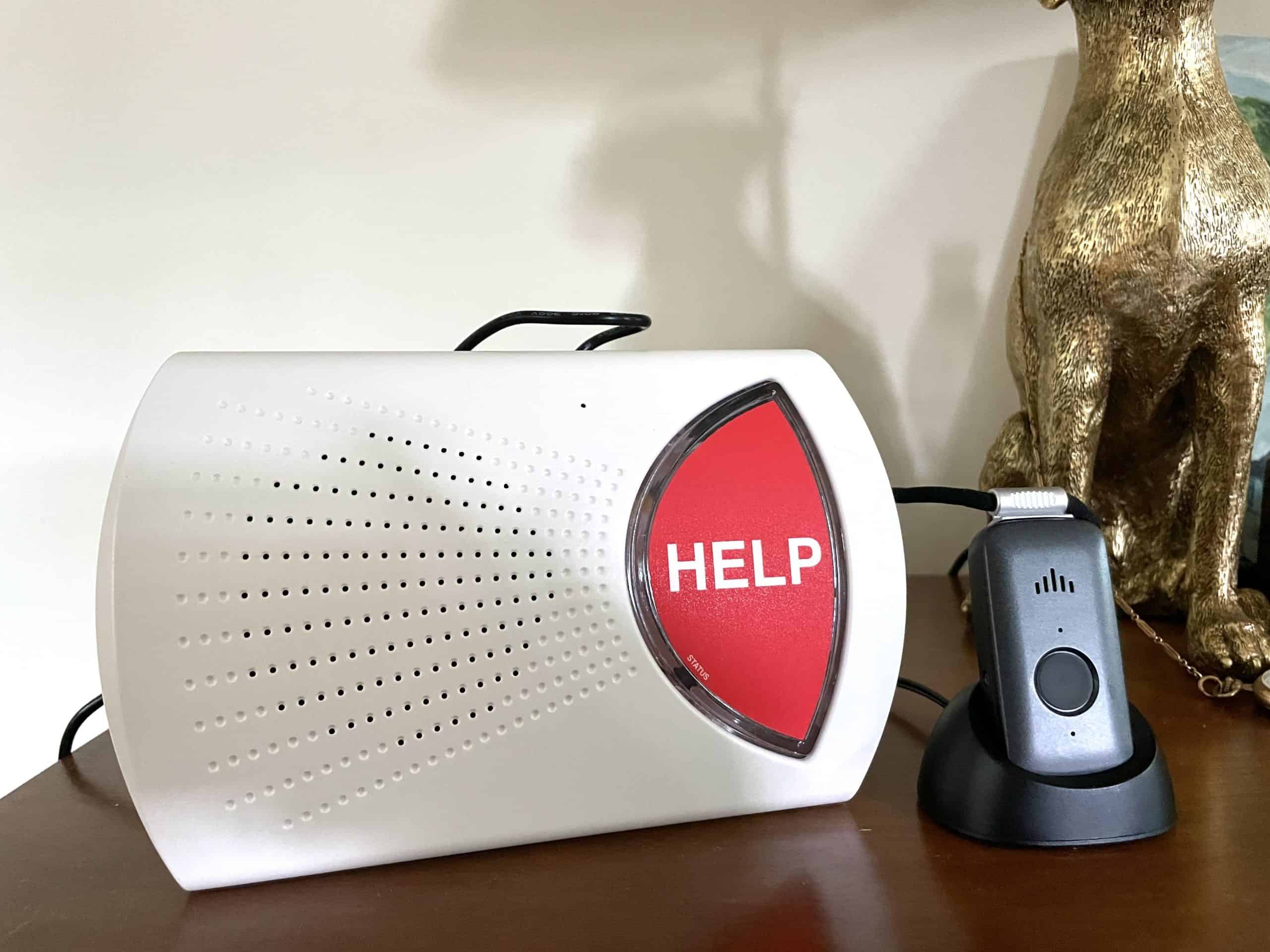
All these features come at a surprisingly low cost. Bay Alarm Medical starts at $24.95 per month for the in-home systems and $34.95 for the mobile systems. That puts the company’s prices at slightly below average.
>>Read More: SOS Micro Review
Most importantly, none of Bay Alarm Medical’s systems require long-term contracts. After testing our systems, we called the company to cancel our service, shipped our devices back and stopped making monthly payments.
To learn more about the pricing of each system and the optional accessories, read our guide to Bay Alarm Medical costs.
Drawbacks
The one downside of Bay Alarm Medical is the extra costs for some bonus features. Even though fall detection is built into most of Bay Alarm Medical’s devices, for example, we had to pay an extra $10 per month to activate it — the same cost as Medical Guardian.
We also appreciated that Bay Alarm Medical includes free access to a caregiver app, through which loved ones can keep track of a device’s location and usage. The app doesn’t have the communication features of other apps, however, such as those from Medical Guardian.
>>Read more: SOS All-In-One 2 Review
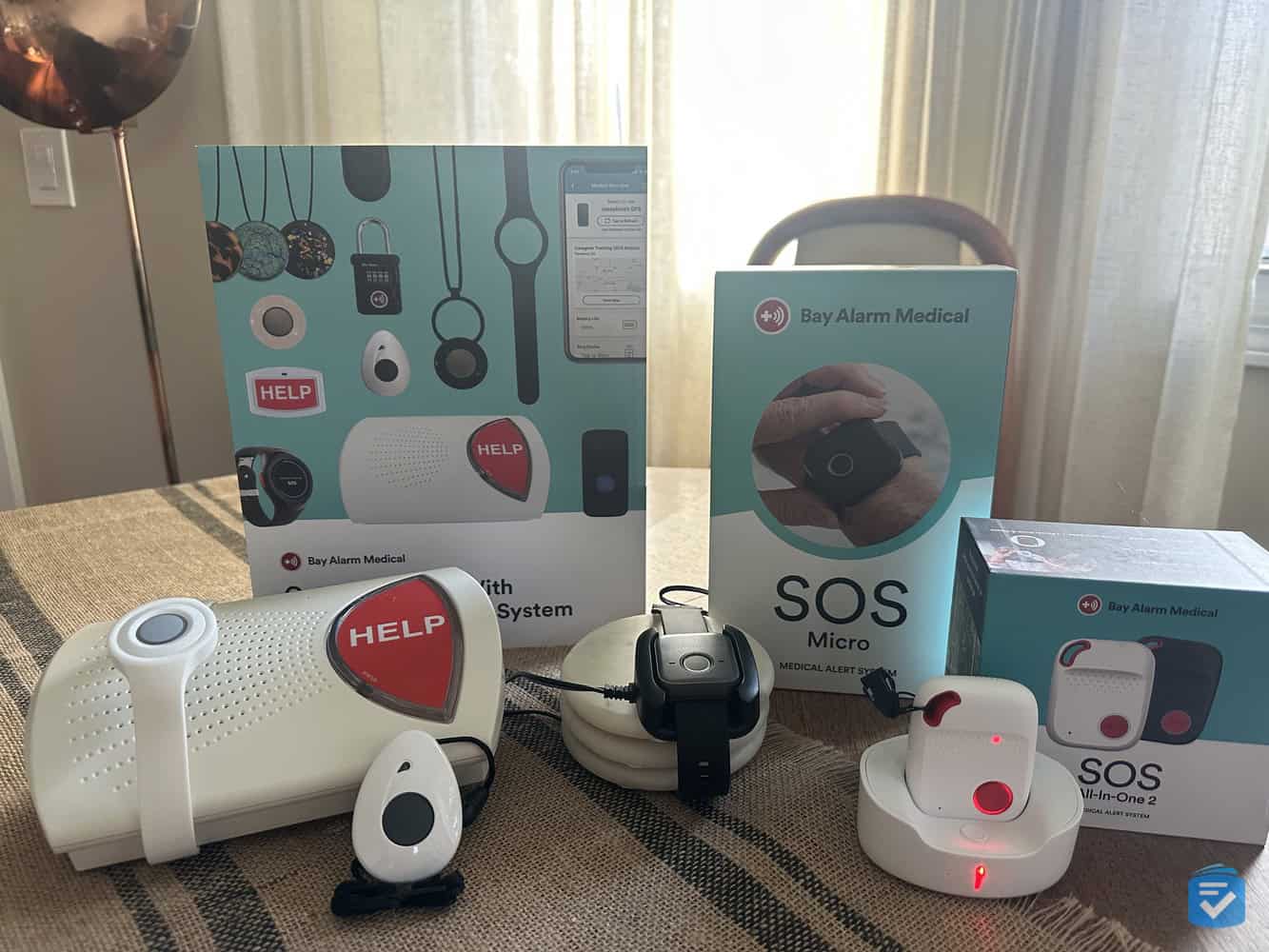
To learn more about our experience with each of the company’s systems, read our Bay Alarm Medical review.
Pros
- No long-term contracts required
- Quick response times
- Mobile GPS tracking
- Caregiver features
- Systems from $24.95 per month
- Voice and wall-mounted buttons
Cons
- Equipment fees for mobile systems
- Less advanced app than others
Medical Guardian - Fastest Response Times
What We Like Most:
- No long-term contracts
- Quick response times
- Activity tracking
- GPS location technology
Overview
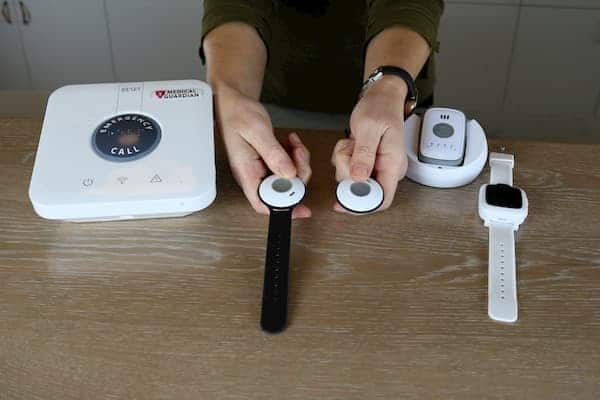
During our tests of Medical Guardian’s five systems, the company’s response agents answered our test calls faster than any other company. Their prices may be higher than the competition’s, but it may be worth the entry cost.
>> Read more: MGMove Watch Review
Testing
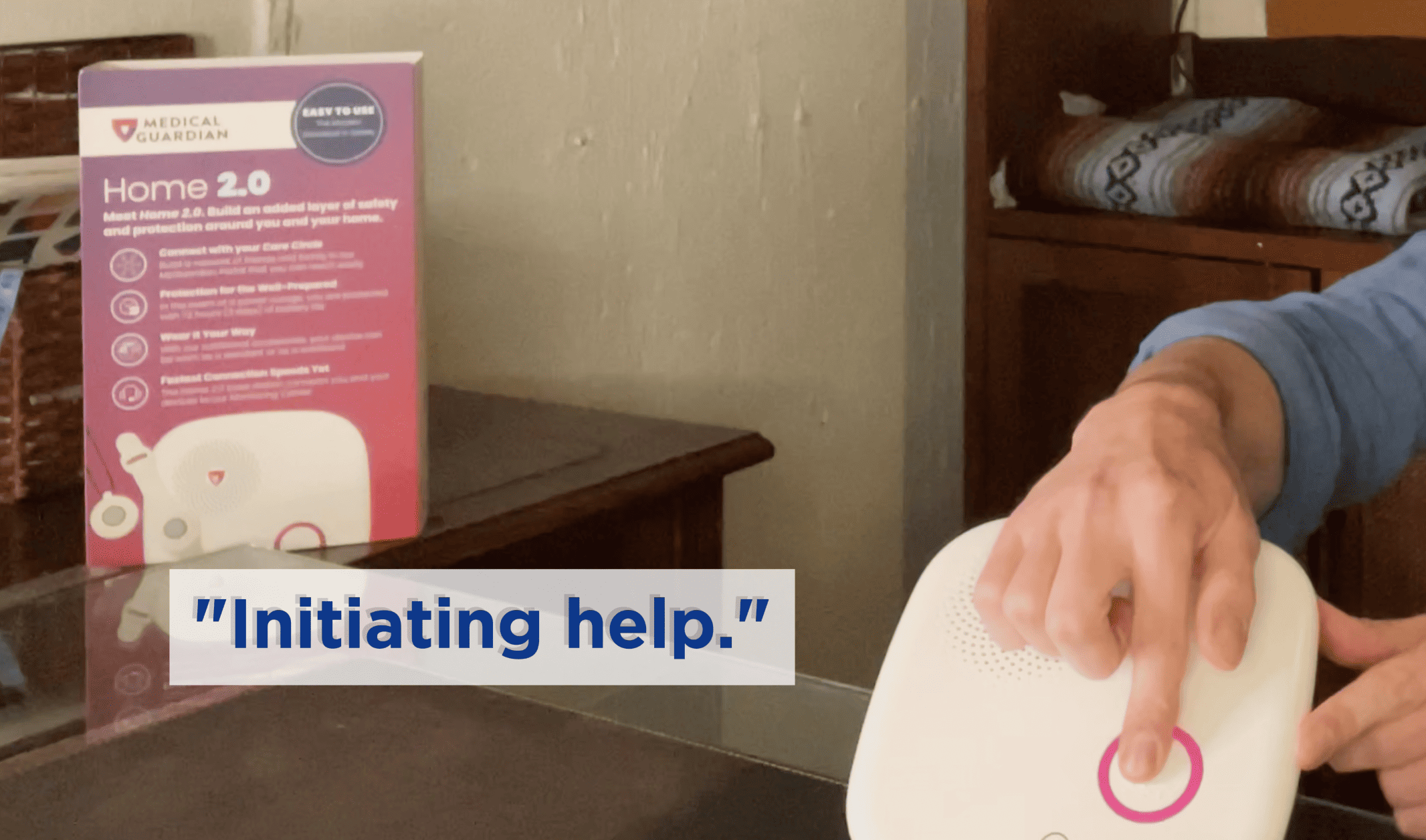
No matter which system we tested, Medical Guardian gave us nearly instantaneous access to help. In our tests, our distress calls were answered in an average of eight seconds, which gave Medical Guardian the fastest response times.
Every Medical Guardian help button is also water-resistant, which allowed us to take them into the shower without causing damage. Fall detection with Medical Guardian was also highly accurate; the systems detected 18 of our 20 test falls.
Another unique feature of Medical Guardian is the MyMedicalGuardian app. Many companies, such as ADT, now offer companion apps with their medical alert systems, but MyMedicalGuardian is by far the best. With the app, the company notifies caregivers when a loved one’s system sends a distress call.
For mobile systems, caregivers can also track the system in real time. With the MGMove watch, we could even use the app to send messages and reminders directly to the watch—something we haven’t seen with any other medical alert system.
To learn more about our experience with the MyMedicalGuardian App, read our MGMini review and MGMini Lite review.
Pricing
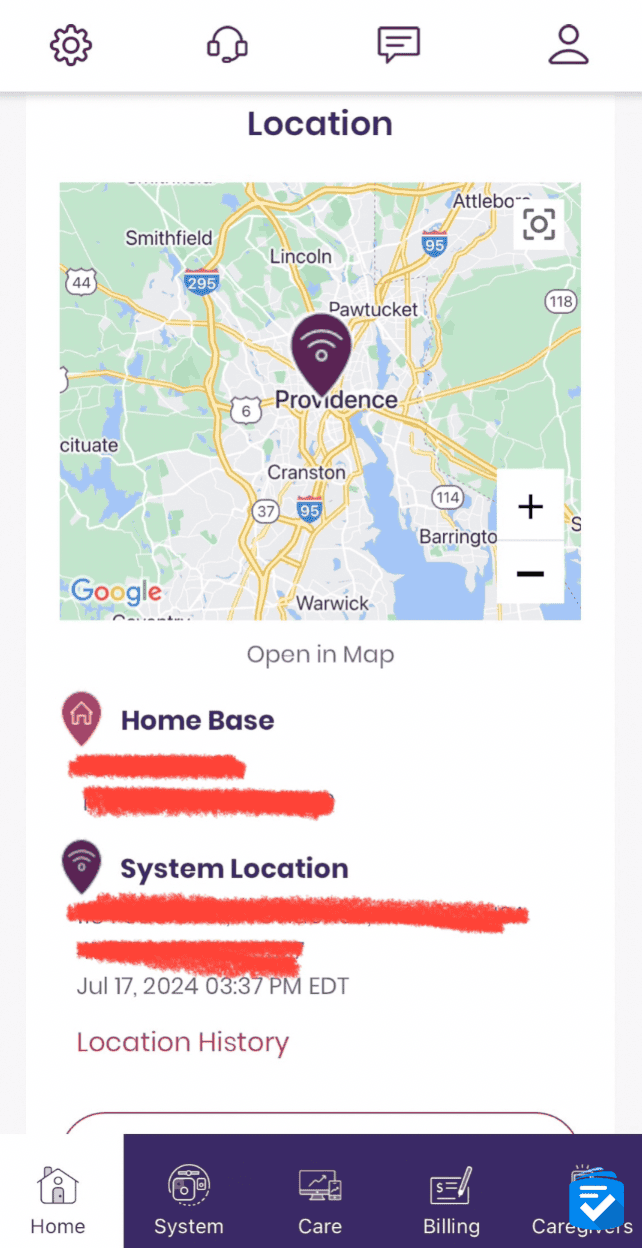
One downside of Medical Guardian is its high costs. The systems start at $27.95 per month for the MGHome Landline, and that’s if you pay $335.50 for a year up front. Monthly payments start at $31.95. The MGHome Cellular costs $34.95 per month (annual contract) or $38.95 (monthly contract), and the mobile systems start at $38.95 per month (annual contract) or $42.95 (monthly contract).
The prices are a bit higher than average. If you’re looking for something slightly more affordable, we recommend checking out MobileHelp, which offers in-home systems for $24.95 per month.
>>Read more: MobileHelp Micro Review
You can get discounts for paying for a whole year in advance, but none of Medical Guardian’s systems require long-term contracts. When we finished testing each system, we returned our equipment, stopped making monthly payments and even received a prorated refund for the remainder of the month.
To learn more about how pricing works with Medical Guardian and what you can expect to pay for each system, read our guide to Medical Guardian costs.
Drawbacks
Apart from the higher-than-average costs, Medical Guardian also charges you additional monthly fees for accessories. Many medical alert companies, like MobileHelp, include a free lockbox. A lockbox allows first responders to enter your home without breaking the door. Medical Guardian, however, charges $2.99 per month for a lockbox.
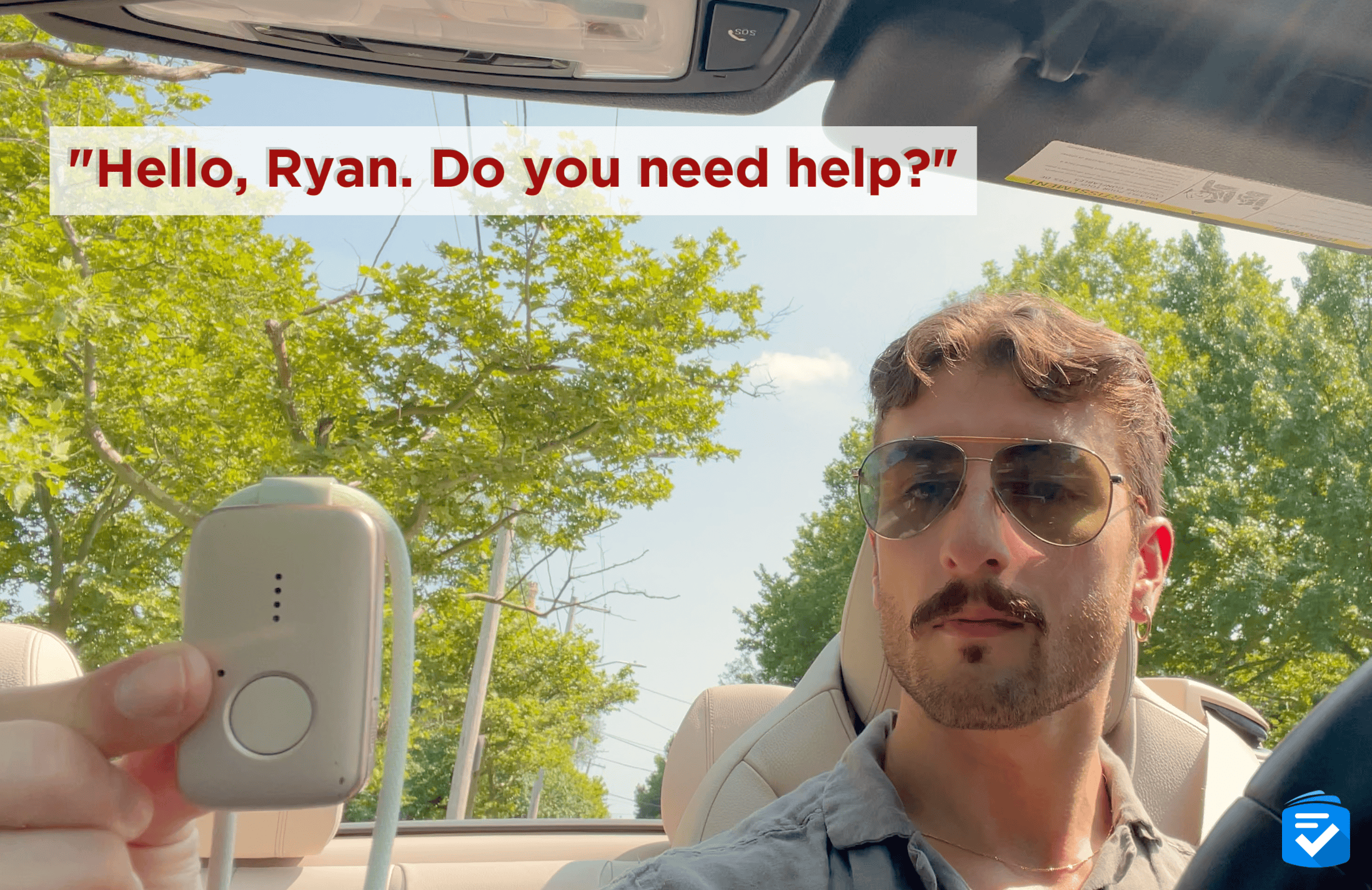
To learn more about our experience, read our Medical Guardian review.
Pros
- Fastest response times
- Wide range of systems
- All-in-one mobile units
- Smartwatch option
- Accurate fall detection
- Waterproof devices
Cons
- More costly than other companies
- Getting the lowest prices requires annual contracts and up-front payments
FYI: Studies indicate that medical alert system users experience 30 percent fewer emergency room visits due to faster, more appropriate emergency response.3
ADT - Best In-Home Systems
What We Like Most:
- Waterproof help buttons
- Optional fall detection
- Quick response times
- Temperature monitoring
Overview
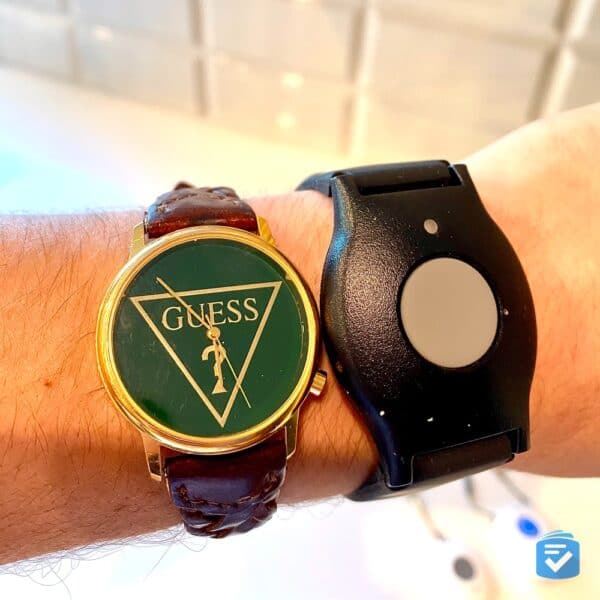
Widely known for its home security systems, ADT also offers medical alert systems that can keep users safe both in and outside their homes. You won’t find much groundbreaking technology here, but ADT medical alerts deliver exceptional performance with durable equipment and speedy emergency response times.
Testing

In our 10 test calls with ADT devices, the company’s response agents answered in an average of 14 seconds. That gave ADT the third-fastest response time on this list, surpassed by only Medical Guardian and Lively.
The buttons worked even when we made calls from the shower. Fall detection on our ADT systems also worked well, detecting 14 out of our 20 test falls.
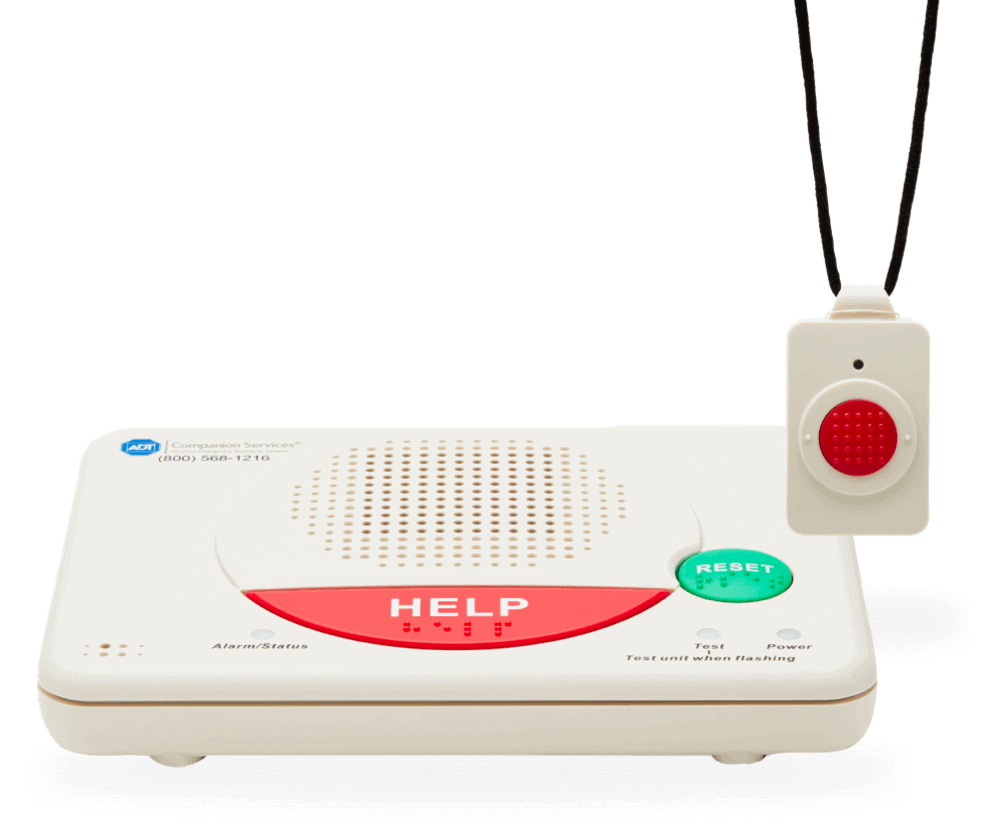
The GPS capabilities of our On-the-Go system also impressed us. When we made a test call from a local train station, the response agents reported our exact location down to the fact that we were standing on the outbound platform.
Pricing
ADT’s prices fall in the middle of the pack. The landline system costs $26.99 per month, the cellular home system costs $34.99 per month and the mobile system costs $36.99 per month. Fall detection costs an additional $11 per month. If you’ve made it this far, you’re likely aware that that’s roughly average for a medical alert system.
>> Read more: The Most Affordable Medical Alert Systems
Like the other companies on this list, including Bay Alarm Medical and Medical Guardian, ADT did not lock us in to a long-term contract. When we finished testing, we canceled our service and stopped making monthly payments.
To learn more pricing, read our guide to ADT medical alert costs.
FYI: In addition to medical alert systems, ADT sells home security systems, which we’ve also tested. Read our review of ADT home security to learn more.
Drawbacks
ADT requires a $99.99 activation fee, while companies such as Medical Guardian forgo activation fees completely. We were also disappointed that Medical Alert Basic does not include fall detection as an option.
To learn more about our experience, read our ADT medical alert review.
Pros
- Waterproof help buttons
- No long-term contracts
- Automatic fall detection
- Quick response times
- Landline options available
Cons
- Relatively small in-home range
- No fall detection on the landline system
- $99.99 activation fee
MobileHelp - Best Budget Options
What We Like Most:
- Systems from $24.95 per month
- Flexible contracts
- Mobile and in-home protection
- Free equipment and activation
Overview
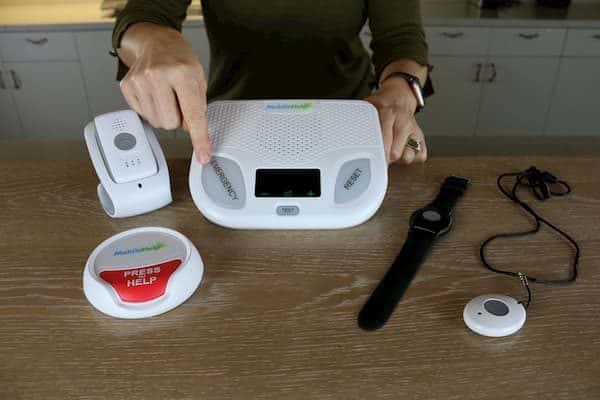
MobileHelp offers several systems that quickly give you or your loved one access to emergency help. Best of all, they cost as little as $24.95 per month, tying it with Bay Alarm Medical and Lively for the most affordable option on this list.
>> Read more: The Best GPS Medical Alert Systems
Testing
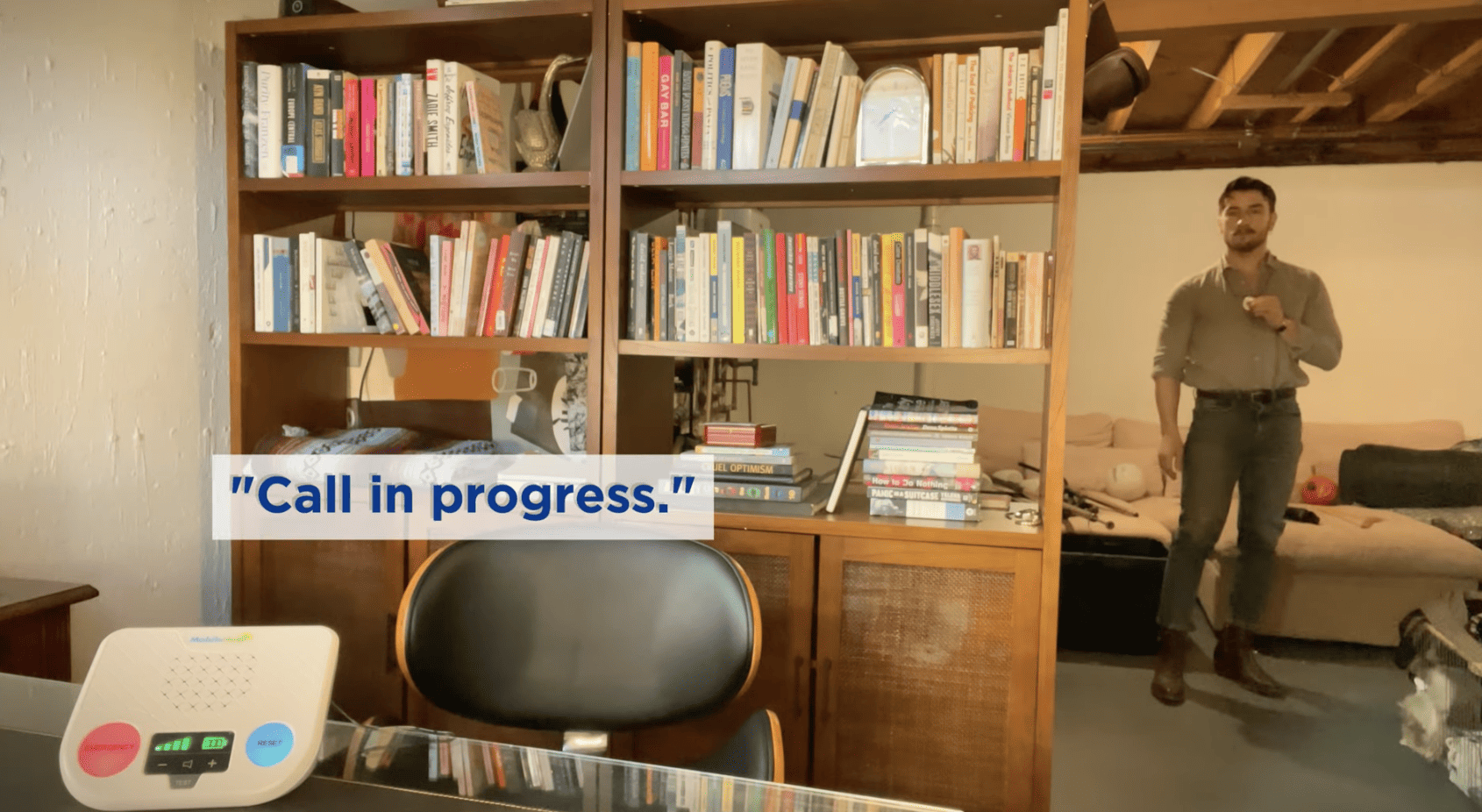
We found consistently solid performance across MobileHelp’s systems. In our test calls, MobileHelp agents answered the call in an average of 26 seconds. That’s longer than the prior two entries on this list, but it’s still better than the 30-second average across the industry. In our opinion, it’s fast enough to keep our loved ones safe.
Another MobileHelp feature that impressed us was the loud volume on its in-home systems. Even when making a test call from multiple rooms away, the Classic system’s speakerphone could handle the call between us and the operators. The Classic system is a good option for someone with hearing impairments.
Pricing
MobileHelp’s most significant advantage is its low cost. Its basic in-home system, the MobileHelp Classic, costs $24.95 a month, while a similar system from Medical Guardian starts at $34.95 a month if you pay annually or $38.95 if you pay monthly.
Like all of the other companies on this list, MobileHelp requires no long-term contracts. Discounts are available if you pay in annual or quarterly installments, much like Medical Guardian. After testing our MobileHelp systems, we returned our devices and canceled our service.
To learn more about pricing, read our guide to MobileHelp costs.
Drawbacks
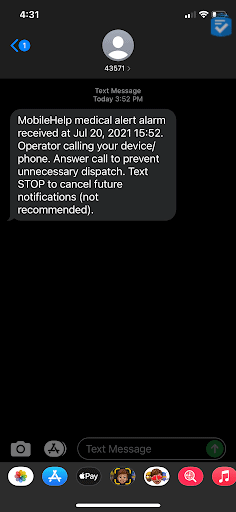
Our main gripe with MobileHelp is its approach to caregiver portals. Other companies, such as Bay Alarm Medical and Medical Guardian, include access to their apps at no extra charge, but MobileHelp charges extra to unlock certain features.
For our contacts to be alerted during an alarm, for example, we had to pay an extra $2.99 per month. That isn’t a huge amount, but it made us feel nickel-and-dimed. If you want caregiver tracking included, MobileHelp isn’t for you.
To learn more about our experience, read our MobileHelp review.
Pros
- Affordable systems
- In-home and mobile protection
- Caregiver portal
- Free lockbox with every order
- Quick response times
Cons
- Extra fees on the caregiver portal
- Extra device required for fall detection
Lively Mobile2 - Best Caregiver Features
What We Like Most:
- Long battery life
- Fully waterproof
- 13-second response times
- Built-in fall detection
Overview
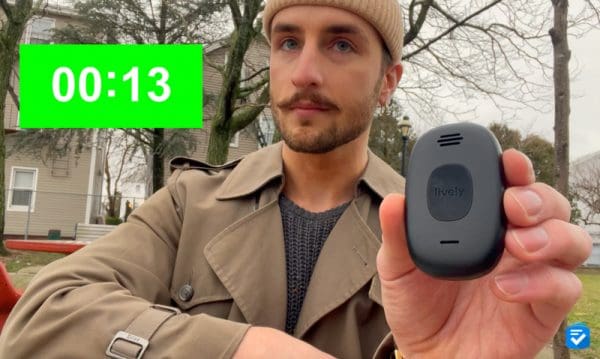
You’ve likely heard of Lively — formerly known as GreatCall — and its popular line of easy-to-use cell phones, the Jitterbug. What you may not have heard of, though, is its stand-alone medical alert device, the Lively Mobile2. It combines the portability of a cell phone with the safety features of a personal emergency response system.
The Lively Mobile2 is a completely cellular medical alert system that includes features such as fall detection and a dedicated nurse hotline. There’s also an app, Lively Link, that allows families and caregivers to tune in to a user’s health and safety.
>> Read more: Jitterbug Smart4 Review
Testing
What impressed us most about the Lively Mobile2 was how quickly its agents answered each of our calls. In our 10 test calls, Lively connected us to help in an average of 13 seconds, the second-fastest average on this list, behind Medical Guardian’s eight seconds.
Lively bills the Mobile2 as a truly waterproof device, whereas other mobile systems on this list are simply water-resistant. To test that, we dunked the device into a glass of water. After pulling it out, it made another test call with crystal-clear audio.
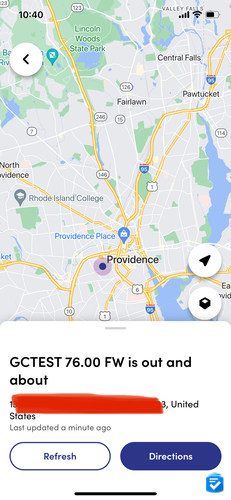
By logging in to the Lively Link app, loved ones could keep track of our device’s location even when we left the house. They also received notifications each time we made a test call. Lively would be a good option for someone with caregivers who want alerts on their loved one’s locations.
>> Further reading: The Best Fall Detection Devices
Pricing
Lively prices start at a mere $24.99 per month with no long-term contracts or cancellation fees.
For an additional $10 a month, the Premium package includes a care advocate who can help you meet your health goals, as well as an on-call nurse who is available for prescriptions and medical advice.
Finally, you can add fall detection to either plan for an additional $9.99 a month, bringing the maximum cost up to $44.98 per month.
To learn more about pricing, read our guide to Lively medical alert costs.
Drawbacks
The biggest drawback to the Lively Mobile2 is that it’s a bit large. In our team’s experience providing care to older adults, we’ve found that it’s very difficult to get a loved one to wear any medical alert device — let alone one that’s large and made of plastic. If you’re looking for something a bit smaller, then I’d recommend Medical Guardian’s MGMini.
To learn more about our experience, read our Lively Mobile2 review.
Pros
- Waterproof device
- 30-day trial period
- No long-term contracts or cancellation fees
- Plans from $24.99 per month
Cons
- Device requires daily charging
- Unattractive design
Other Medical Alert Systems We’ve Tested
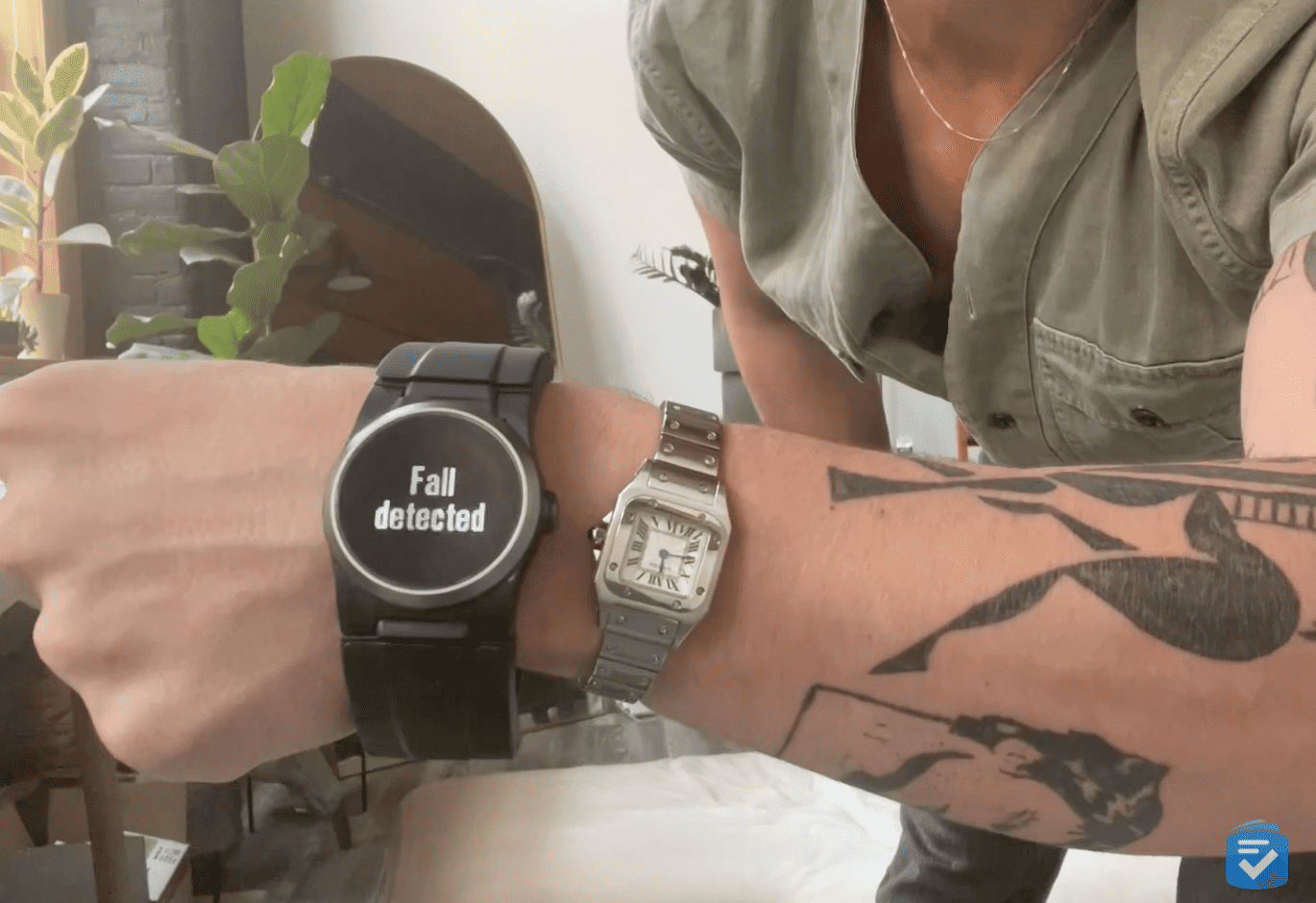
Although we would never recommend Life Alert for any user, several other medical alert systems impressed us, but did not make the cut. Each of the systems below possesses some unique features that make it worth considering.
UnaliWear Kanega Watch
This medical alert watch not only has accurate fall detection, but it also features a unique system of four batteries that allows the user to wear the device 24/7. Unfortunately, the watch costs $299 up front and a monthly subscription of at least $84.95. Read our Kanega Watch review to learn more.
Lifeline
Arguably the most well-known medical alert brand after Life Alert, Lifeline systems performed well overall. Their above-average pricing, with costs starting at $39.95 for its mobile system, keep it from making the cut. Read our Lifeline review to learn more.
What to Avoid When Buying a Medical Alert
Here are some red flags to look out for when buying a medical alert system.
Long-term contracts: Some providers will lock you into a three-year contract with no option to cancel. Make sure the company you’re signing up with has a monthly option.
High fees: From high equipment fees to high monthly fees, some companies are overpriced. UnaliWear, for example, charges $299 for its smartwatch and at least $84.95 per month, many times more than competitors such as Medical Guardian and Bay Alarm Medical.
Lack of fall detection: Check for this essential feature when considering a medical alert system. Some systems, such as Life Alert, don’t include it.
Slow response: Make sure to read our reviews to find out how quickly companies respond to alerts. A difference of even a few seconds could mean everything during an emergency.
How Do Medical Alert Systems Work?
At their core, all medical alert systems have a similar function. When you trigger them, by either falling or pushing the button, they will connect you to a monitoring center, whose personnel will assess your situation and, if necessary, contact emergency services.
There are several types of medical alert systems for use both in and outside the home. Below is an overview of the categories.
To learn more about these devices, read our guide to medical alert devices.
In-Home Medical Alert Systems
In-home medical alert systems fall into two categories: landline and cellular. Both types of in-home systems include a base station with a two-way speaker. The speaker communicates with monitoring personnel. The user activates the speaker by pressing a small help button they wear around either their neck or wrist.
Landline systems: Landline systems require a working landline to connect with a monitoring center. They are easy to install: Just plug them into a power outlet and phone jack. Landline systems tend to be the most affordable option.
Cellular systems: If you don’t have a landline, consider cellular medical alert systems. Plug in the power source and the system will initiate. Cellular systems often look identical to their landline counterparts, but they usually cost $5 to $10 more, which includes the cost of cellular service.
FYI: Before purchasing a cellular system, verify that your home receives adequate cellular coverage by asking which cellular carrier (usually Verizon or AT&T) the medical alert company uses. If your home doesn’t have adequate cellular coverage, your system won’t work properly.
Mobile Medical Alert Systems

Mobile medical alert systems are ideal for people who want access to help even while outside their homes. Using a cellular connection, the devices feature a two-way speaker and a help button, giving you the same protection as an in-home system but in a portable package.
All mobile medical alerts are even GPS-enabled. That allows monitoring staff and loved ones to locate a user while their device is turned on, which is important since some users may be unable to verbalize their location if they are hurt, confused or otherwise experiencing an emergency.
Medical Alert Watches
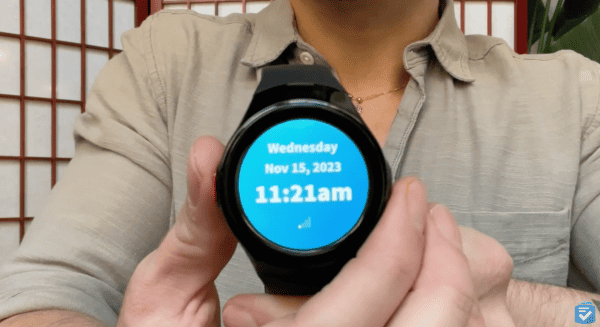
The medical alert smartwatch provides safety in a sleek and discreet package. The systems work independently of a cell phone, and they look like a typical wristwatch. Not only are they stylish, lifesaving devices, but they also operate as a functional watch, activity tracker and messenger.
To learn more about the systems, read our guide to the best smartwatches for seniors.
How Does Medical Alert Monitoring Work?
Medical alert systems function as a direct contact line between the user and a monitoring center. Medical alert companies contract monitoring centers to provide 24/7 care to customers. They do so by receiving distress calls, assessing the situation (emergency or otherwise) and then contacting an appropriate response measure.
Monitoring centers are not your average call center. Not only are they staffed well enough to field calls in a matter of seconds, but their specialists also often receive extensive training to ensure a high degree of care.
Not all medical alert systems, however, require monthly fees. To learn more, check out our list of unmonitored medical alert systems.
How to Choose a Medical Alert System
If you’re interested in purchasing a medical alert system, here are some questions you should consider.
In-Home or Mobile?
Medical alert systems can be broken down into two categories: systems for use in the home and systems for use outside.
In-home systems connect through either a landline or cellular connection. When you press your help button — generally worn as either a wristband or pendant — you’ll be connected to the monitoring center via the base station, which has both a speaker and microphone for easy communication. In-home systems are best suited for people who spend most of their time indoors, although some systems have a large enough connectivity range to cover parts of your yard.

Mobile systems connect through cellular service, allowing you to travel just about anywhere with adequate service. Most often worn as a pendant, the systems provide the same security and peace of mind as in-home models, but with a greater range. The systems generally are more expensive.
What Are Your Monitoring Needs?
Each of the systems mentioned here comes with some form of 24/7 professional monitoring, but some offer additional features suited to individual needs.
With caregiver apps and platforms, loved ones and caregivers can keep tabs on the user, tracking their location, monitoring their activity and even checking to make sure they’re wearing their device. Systems from Aloe Care Health, for example, are rooted in their smartphone app. With the app, loved ones can make check-in calls to a system, communicate with other caregivers and even monitor system metrics such as home temperature, carbon monoxide levels and emergency alerts sent from the device.
Many medical alert providers also offer personalized response plans. With these plans, a call to the monitoring center can also trigger alerts to neighbors or loved ones. A monitoring agent can certainly contact emergency services, but not every help call requires such drastic action. We always appreciate these individualized responses.
How Much Is Your Budget?
Consider your budget when deciding on a medical alert system. First, there are equipment fees. Some companies, such as MobileHelp, offer equipment for free, others, such as Medical Guardian, charge around $150 for equipment. There may or may not be a one-time activation fee, as well. Medical Guardian lacks activation fees, while ADT charges $99.99.
Then there are monthly, quarterly or annual recurring costs, which range from about $24.95 to $44.95 a month. Fall detection usually costs $10 a month. Landline systems tend to be the most affordable in terms of subscription fees, while mobile smartwatches tend to cost the most.
What Is Automatic Fall Detection?

A fall can leave a person unable to reach for help, and that’s where medical alert systems with fall detection come in handy.
Through accelerometer technology, automatic fall-detection pendants can detect a fall and automatically call monitoring personnel without the user having to press the button. The technology is not 100 percent accurate and false alarms can occur, but we always recommend the feature for added peace of mind.
Do You Want Fall Detection?
Most medical alert systems offer automatic fall detection, which costs between $5 and $15 extra per month. It may be tempting to omit the feature to save money, but we think it’s essential and could even save your life.
Since falls are a leading cause of injury for those ages 65 or older,4 we always recommend spending the extra money on the feature.

Can an Apple Watch Replace a Medical Alert System?
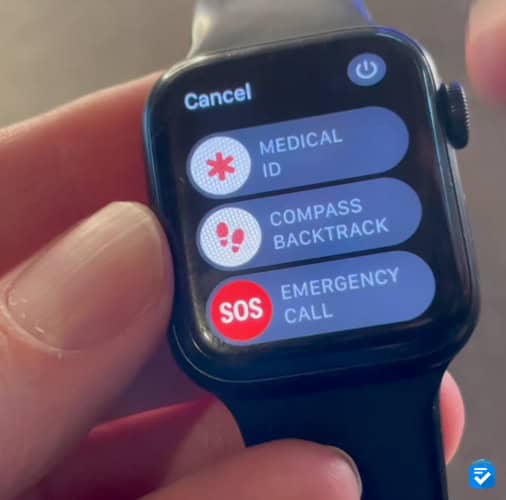
The current lineup of Apple Watches includes emergency calling, fall detection and location tracking for loved ones, as well as a slew of entertainment and health features. If you plan to use an Apple Watch instead of a medical alert system, however, there are a few things you should consider.
With an Apple Watch, emergency calls are routed to 911 operators. The operators can often detect a user’s location through the watch, but they do not possess other information about the user, which means they can only send emergency services. That poses issues if a user falls and is not injured, but cannot get back up on their own — 911 will only be able to call an ambulance.
If a person calls 911 with an Apple Watch and is unable to speak, the operators likely won’t send anyone to help. A monitoring agent, in contrast, can contact a neighbor for a wellness check-in.
To learn more about how Apple Watches stack up with medical alert systems in terms of features, costs and fall-detection accuracy, read our full guide: Apple Watch vs. Medical Alert Systems.
Bottom Line
Medical Guardian has the fastest response times, while ADT has the best in-home systems, Lively has the best options for caregivers, MobileHelp is best for those on a budget and Bay Alarm Medical works well for people who need help in and out of the home.
As caregivers to older adults, we take great pride in helping people navigate the often complicated world of medical alert systems. Everyone deserves independence, regardless of age, and a reliable medical alert system is the perfect tool to help you do so.
If you made it this far, you can tell there is a lot to know about these systems. But have no fear! We’re here to do the leg work, testing the latest and greatest caregiver technology and making it easier for you to rest assured that your loved ones are aging gracefully.
Methodology
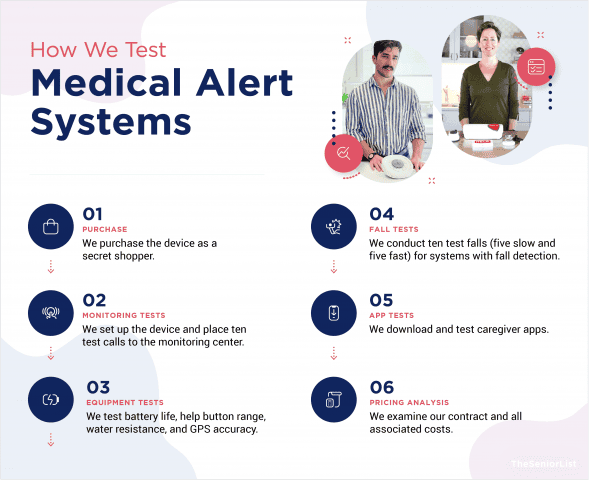
Most medical alert companies sell a variety of systems, including in-home systems, mobile systems and smartwatches. Each device has unique features, but they all offer the same basic function: connecting a user to help during an emergency. With that in mind, we evaluated every medical alert system on the criteria below.
- Response times: We conducted 10 test calls for each system, counted how long it took to receive a response and calculated an average response time.
- Ease of use: It’s essential that a user can successfully activate their system during an emergency, so we evaluated each device’s design with simplicity at the forefront.
- Customer care: The human touch is key to caregiving, so medical alert companies must offer impeccable customer service, from the agents at their monitoring centers to their support personnel.
- Affordable pricing: Most medical alert systems cost between $20 and $50 per month, and all the systems on this list fall within that range.
- Flexible contracts: We included only companies that allowed us to subscribe monthly and cancel anytime.
- Extra features: In recent years, medical alert systems have incorporated voice commands, automatic fall detection and caregiver portals that allow loved ones to communicate with a system from afar. Not everyone needs all those features, but we factored them into the rankings.
Frequently Asked Questions
-
What is the best medical alert device on the market?
MobileHelp, Bay Alarm Medical and Medical Guardian make some of the most reliable and affordable medical alert devices on the market.
-
Are medical alert systems worth it?
Costing as little as $20 per month, a medical alert system is one of the most affordable ways for seniors to stay safe in their homes and on the go — especially compared to more costly home modifications.
-
What is the average cost of a medical alert system?
On average, medical alert systems cost between $20 and $50 per month. Additional buttons and features, such as fall detection, usually cost an additional monthly charge.
-
Do you need Wi-Fi for medical alert systems?
No, you do not need Wi-Fi for most medical alert systems. They work through either your landline or cellular connection.
-
Does Medicare pay for medical alert systems?
No, Medicare will not pay for medical alert systems since they are not considered durable medical equipment. Some private insurance providers, however, offer partial coverage for medical alert systems.
-
Where can you buy a medical alert system?
Some brands of medical alert systems are carried in stores such as Walmart and CVS, but most medical alert providers, including Medical Guardian, Bay Alarm Medical and MobileHelp, sell their devices over the phone or on their websites.

